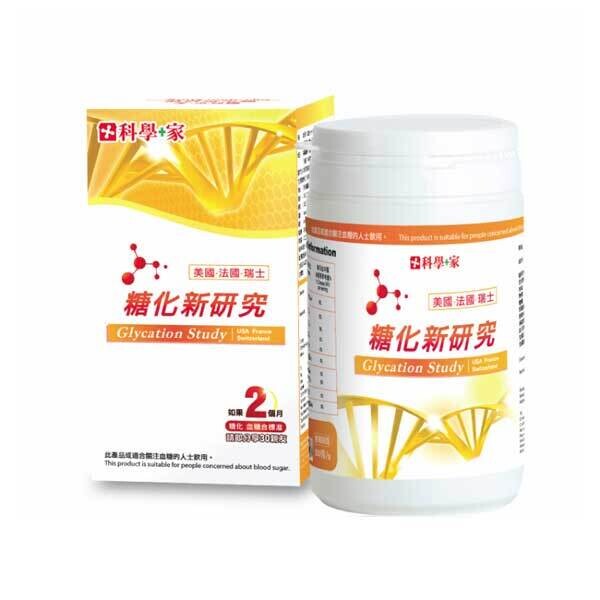科學+家 糖化新研究 | SCIENTIST HOME Glycation Study
糖化過程
糖化是在體內的一個不能逆轉的非酶化學過程,血液中的葡萄糖會結合體內的蛋白質或脂肪,因為體內組織大部分由蛋白質組成,故此組織的蛋白質被糖化會破壞組織的完整性,對不同的器官造成損害。
糖化可以出現在身體不同的地方,引起不同的併發症例如:
‧血管-糖化會令血管硬化,使血管失去彈性,令血壓上升
‧腎臟–糖尿病晚期會出現腎臟衰竭
‧視網膜血管–影響視力
‧傷口難以癒合–因為細胞被糖化受損
另外,高血糖會促使體內經過一連串的化學反應而產生糖化終產物。糖化終產物會結合在不同細胞的受主,引起發炎反應。總括而言,(i)組織直接的糖化和(ii)因糖化終產物而起的發炎會令身體的細胞受損,以及影響身體對受損組織的自行修復。
而且檢測自身亦有些微誤差,如有疑似糖尿病(HbA1c > 6.5),應建議到醫院作詳細檢查,診斷是否患上糖尿病
糖化研究可以抑制糖化過程:
(i)抑制組織自身的糖化過程,使細胞代謝回到比較正常的水准,有利於身體自行的修復
(ii)抑制體內產生糖化終產物,减少組織的發炎反應
(iii)透過身體的自行修復,被糖化的組織會逐漸被新生組織取代,使病情得到改善
改善的過程長短要視乎受損的組織的新陳代謝,血管新陳代謝較快(幾星期到一年),所以抑制糖化後比較容易觀察到血壓的改善,然後傷口癒合的速度亦會逐漸得到改善(皮膚的半衰期為幾個月到幾年)
對於半衰期較長的組織,例如眼角膜約為80多年,所以糖化研究未能有效改善因為細胞糖化而受到器官功能上受損的影響,但仍可以有助抑壓併發症的病情惡化
糖化研究改善情况的跟進:
(i)三個月檢測一次的糖化血紅蛋白
(ii)一星期量二次血壓(早上剛睡醒和晚上睡覺前)
科學+家 糖化新研究 200克/粉劑/瓶裝
適合關注:
氧化糖化(1,2,3)、腎健康(4)、視網膜健康(3)、胰島素質量(5)、糖化終產物(6,8)、血糖水准(7)、血管和神經健康(8)、足部癒合(9)
- 本品或適合關注血糖、糖化人士飲用
- 本品為營養補充品,不能代替藥物
- 懷孕或哺乳期女士、嬰幼兒,請不要食用本品。
- 如不瞭解問題原因或問題持續,請儘快諮詢醫生
飲用方法:每天早晚各一次,每次2.5茶匙,餐前飲用,以溫開水衝開,即可飲用
成份:赤蘚糖醇、肌醇、可哥、牛磺酸、大麥芽、瑪黛茶、迷迭香、芒果苷、槲皮素、香草醛、羅漢果、鉻組氨酸
規格型號:200克/粉劑/瓶裝
原產地:中國香港
Saccharification process
Glycosylation is an irreversible non enzymatic chemical process in the body. Glucose in the blood will combine with protein or fat in the body. Because most tissues in the body are composed of protein, glycosylation of protein in the tissue will destroy the integrity of the tissue and cause damage to different organs.
Glycosylation can occur in different parts of the body, causing different complications, such as:
- Blood vessels - glycosylation can harden blood vessels, make them lose elasticity and raise blood pressure
- Kidney - kidney failure occurs in the late stage of diabetes
- Retinal vessels - affect vision
- Wounds are difficult to heal - because cells are impaired by glycosylation
In addition, hyperglycemia will promote the body through a series of chemical reactions to produce advanced glycation end products. Advanced glycation end products (ages) bind to different cellular receptors, causing inflammation. To sum up, (I) direct glycosylation of tissues and (II) inflammation caused by advanced glycation end products will damage the body's cells and affect the body's self repair of damaged tissues.
Moreover, there are some micro errors in the detection itself. If there is suspected diabetes (HbA1c > 6.5), it is recommended to go to the hospital for detailed examination to diagnose diabetes.
Saccharification research can inhibit the process of saccharification
(i) Inhibit the glycosylation process of the tissue itself, make the cell metabolism return to a relatively normal level, which is conducive to the body's self repair
(II) inhibit the production of advanced glycation end products in the body and reduce the inflammatory reaction of tissues
(III) through the self repair of the body, the glycosylated tissue will be gradually replaced by new tissue, so that the condition will be improved.
The process of improvement depends on the metabolism of the damaged tissue. The metabolism of blood vessels is faster (from a few weeks to a year). Therefore, it is easier to observe the improvement of blood pressure after inhibiting glycosylation, and then the speed of wound healing will be gradually improved (the half-life of skin is from a few months to a few years)
For tissues with long half-life, such as cornea, it is more than 80 years, so glycosylation research can not effectively improve the damage of organ function caused by cell glycosylation, but it can still help to suppress the deterioration of complications
Follow up on the improvement of saccharification research:
(i) Glycosylated hemoglobin tested once every three months
(II) blood pressure measurement twice a week (just before waking up in the morning and before going to bed at night)
Scientist Home Glycation Study / 200g / powder / bottle
Possible supplements supporting:
Oxidative glycation (1,2,3), Renal health (4), Retinal health (3), Insulin quality (5), Advanced glycation end products (6,8), Blood glucose level (7), Vascular and neurological health (8), Foot healing (9)
- This product may be suitable for people who pay attention to blood sugar and glycosylation
- This product is a nutritional supplement and cannot replace medicine
- Please do not take this product for pregnant or lactating women and infants.
- If you do not understand the cause of the problem or the problem continues, please consult your doctor as soon as possible
Consumption: 2.5 teaspoons each time, one time in the morning and one time in the evening, before meals, with warm boiled water
Ingredients: erythritol, inositol, cocoa, taurine, malt, mate tea, rosemary, mangiferin, quercetin, vanillin, Siraitia grosvenorii, chromic histidine
Package: 200g / powder / bottle
Origin: Hong Kong, China
研究資料參考 References :
- Ishikawa, M., Miyashita, M., Kawashima, Y., Nakamura, T., Saitou, N. and Modderman, J. (1996). Effects of Oral Administration of Erythritol on Patients with Diabetes. Regulatory Toxicology and Pharmacology, 24(2), pp.S303-S308.
- Yokozawa, T., Kim, H. and Cho, E. (2002). Erythritol Attenuates the Diabetic Oxidative Stress through Modulating Glucose Metabolism and Lipid Peroxidation in Streptozotocin-Induced Diabetic Rats. Journal of Agricultural and Food Chemistry, 50(19), pp.5485-5489.
- Ramakrishnan, S., Sulochana, K. and Punitham, R. (1998). Two new functions of inositol in the eye lens: Antioxidation and antiglycation and possible mechanisms. Indian Journal of Biochemistry & Biophysics, 36, pp.129-133.
- Li, X., Cui, X., Sun, X., Li, X., Zhu, Q. and Li, W. (2010). Mangiferin prevents diabetic nephropathy progression in streptozotocin-induced diabetic rats. Phytotherapy Research, 24, pp.893-899.
- Miura, T., Ichiki, H., Hashimoto, I., Iwamoto, N., Kao, M., Kubo, M., Ishihara, E., Komatsu, Y., Okada, M., Ishida, T. and Tanigawa, K. (2001). Antidiabetic activity of a xanthone compound, mangiferin. Phytomedicine, 8(2), pp.85-87.
- Lunceford, N. and Gugliucci, A. (2005). Ilex paraguariensis extracts inhibit AGE formation more efficiently than green tea. Fitoterapia, 76(5), pp.419-427.
- Hong, H. and Jai Maeng, W. (2004). Effects of Malted Barley Extract and Banaba Extract on Blood Glucose Levels in Genetically Diabetic Mice. Journal of Medicinal Food, 7(4), pp.487-490.
- Hsieh, C., Peng, C., Chyau, C., Lin, Y., Wang, H. and Peng, R. (2007). Low-Density Lipoprotein, Collagen, and Thrombin Models Reveal thatRosemarinus officinalisL. Exhibits Potent Antiglycative Effects. Journal of Agricultural and Food Chemistry, 55(8), pp.2884-2891.
- Maya S P Huijberts, Nicolaas Schaper, 46.13, Maastricht University, Casper G Schalkwijk. Advanced glycation end products and diabetic foot disease. May 2008. Diabetes/Metabolism Research and Reviews 24 Suppl 1(S1):S19-24. DOI: 10.1002/dmrr.861

